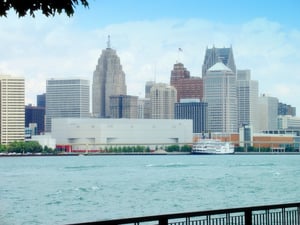Since when has Detroit been an important setting for works of fiction? Sure, if you look to cinema, you might be able to name a number of movies set in Detroit that emphasize characteristics of the city, such as Alex Proyas’s The Crow (1994) or Curtis Hanson’s 8 Mile (2002). But in all honesty, Detroit really wasn’t seen by most readers as a productive literary space until Jeffrey Eugenides depicted the city in new and interesting ways for readers. Detroit, it turns out, is more than just Motown when it comes to artistic production. In both The Virgin Suicides (1993) and Middlesex (2002), Eugenides portrays sides of Detroit that are at once full of nostalgia while also being sites of sadness and great change.
Detroit Suburbs in the 1970s: The Virgin Suicides (1993)
 Eugenides's first novel, The Virgin Suicides takes place in the Detroit suburb of Grosse Point, Michigan in the 1970s. Incidentally, Eugenides also grew up in this part of Michigan around the same time. Narrated from the collective, first-person point of view of a group of teenage boys in the neighborhood who had once been in love with the teenage Lisbon sisters, the novel depicts the sisters’ suicides over the course of a short period of time. The boys, in later adulthood, wistfully attempt to come to terms with the girls’ untimely deaths.
Eugenides's first novel, The Virgin Suicides takes place in the Detroit suburb of Grosse Point, Michigan in the 1970s. Incidentally, Eugenides also grew up in this part of Michigan around the same time. Narrated from the collective, first-person point of view of a group of teenage boys in the neighborhood who had once been in love with the teenage Lisbon sisters, the novel depicts the sisters’ suicides over the course of a short period of time. The boys, in later adulthood, wistfully attempt to come to terms with the girls’ untimely deaths.
The novel is full of lyrical passages, particularly those describing the affluent yet eerie suburb of Detroit in which the text is set. The novel begins with the attempted suicide of the youngest Lisbon sister, Cecilia. As the paramedics arrive, the narrative shifts to the neighborhood space:
“Thaw as in June, fish-fly season, when each year our town is covered by the flotsam of those ephemeral insects. Rising in clouds from the algae in the polluted lake, they blacken windows, coat cars and streetlamps, plaster the municipal docks and festoon the rigging of sailboats, always in the same brown ubiquity of flying scum . . . . The EMS siren shrieked, going away, and the botanist and his crew withdrew their insecticide pumps to watch the truck. When it was gone, they began spraying again. The stately elm tree, also visible in the foreground of Exhibit #1, has since succumbed to the fungus spread by Dutch elm beetles, and has been cut down.”
The novel reimagines the decay of modern Detroit through the language of natural destruction, repulsing readers just enough while also drawing them into the suburban landscape of the Midwestern city. In 1999, Sofia Coppola directed a film adaption of The Virgin Suicides featuring a score by the electronica band Air.
Contemporary Detroit and the History of Immigration: Middlesex (2002)
 Also set in Detroit, Middlesex follows a much different plot as it traces the history of its intersex protagonist, Cal. Cal’s grandparents immigrate to Detroit from a village in Asia minor with the secret that they are brother and sister. As a result of incest, Cal is born with 5-alpha-reductase deficiency. While the novel is set in contemporary Detroit, it moves between periods, going as far back as the 1920s with Cal’s family migration to America.
Also set in Detroit, Middlesex follows a much different plot as it traces the history of its intersex protagonist, Cal. Cal’s grandparents immigrate to Detroit from a village in Asia minor with the secret that they are brother and sister. As a result of incest, Cal is born with 5-alpha-reductase deficiency. While the novel is set in contemporary Detroit, it moves between periods, going as far back as the 1920s with Cal’s family migration to America.
In Middlesex, Detroit goes from being an industrial center to one of violence and riots in the 1960s. Through its first-person narrator, Cal, the novel describes the city around the turn of the century and into the following decades:
“By 1900 Detroit was the leading manufacturer of carriages and wagons. By 1922, when my grandparents arrived, Detroit made other spinning things, too: marine engines, bicycles, hand-rolled cigars. And yes, finally: cars. . . . In those days downtown Detroit was filled with shoppers and businessmen. Outside Hudson’s Department Store the crowd was ten thick, jostling to get in the newfangled revolving doors.”
Yet the novel rapidly shifts to the Detroit of the 1960s and 1970s, and the aftermath of the 1967 Detroit riot. Middlesex won the Pulitzer Prize in 2003.
Eugenides on His Own Detroit Origins
As Eugenides explained of his early work in an interview* in The Paris Review, depicting Detroit in fiction ultimately was a way of moving through his own childhood experiences both in and outside the city:
“When I was born, Detroit was the fourth-largest city in the county. The population stood at more than a million people. But people were already beginning to flee, and in 1967, when the riots occurred, the trickle turned into a flood. My entire childhood coincided with the demise of Detroit. I grew up watching houses and buildings fall apart and then disappear. It imbued my sense of the world with a strong elegiac quality—a direct experience of the fragility and evanescence of the material world.”
If you’re interested in reading more, we recommend picking up a copy of The Virgin Suicides or Middlesex today. Happy reading about Detroit!
*Read Eugenides's full interview here.









